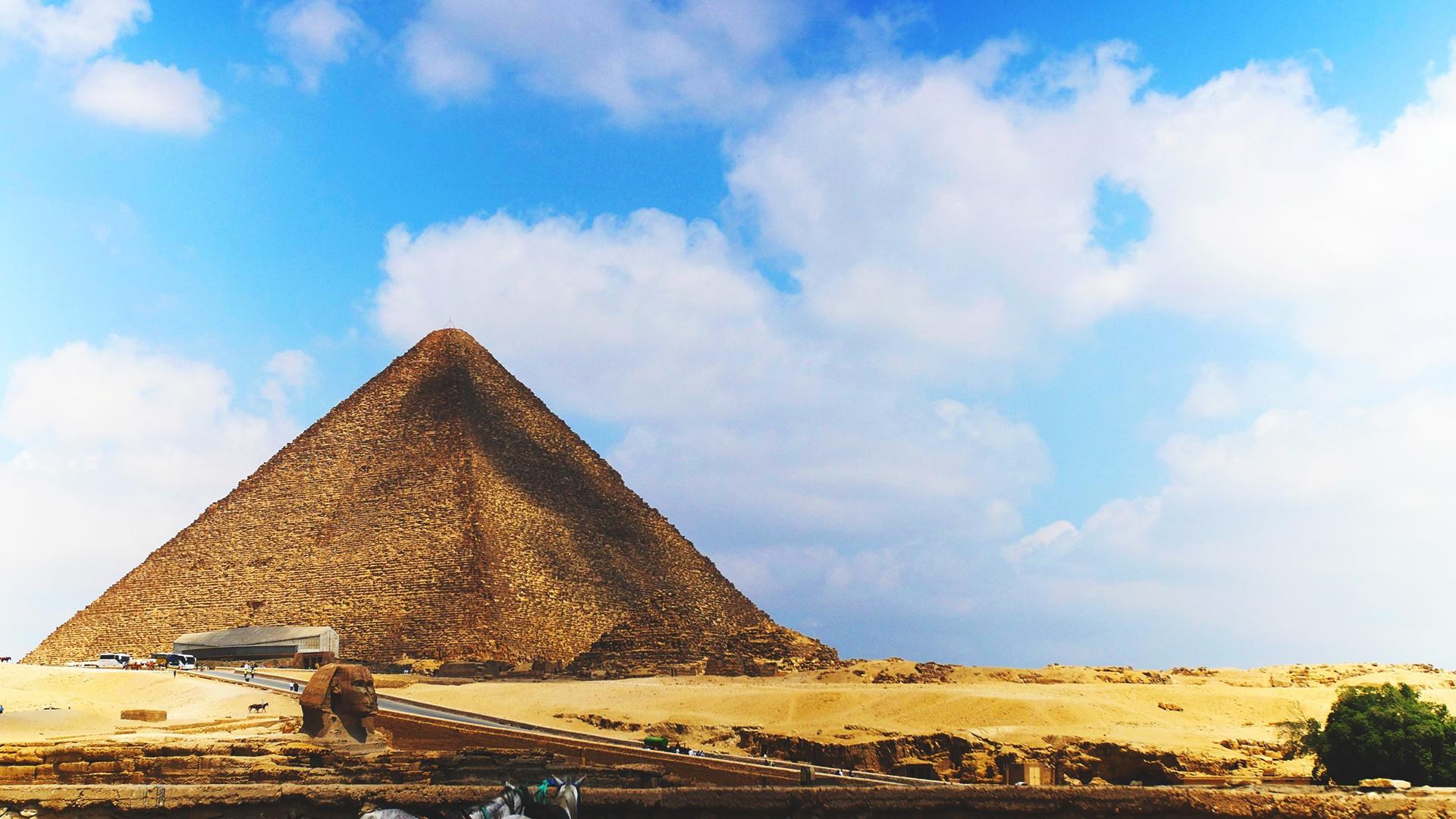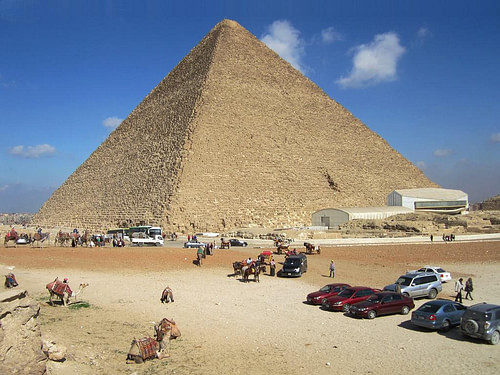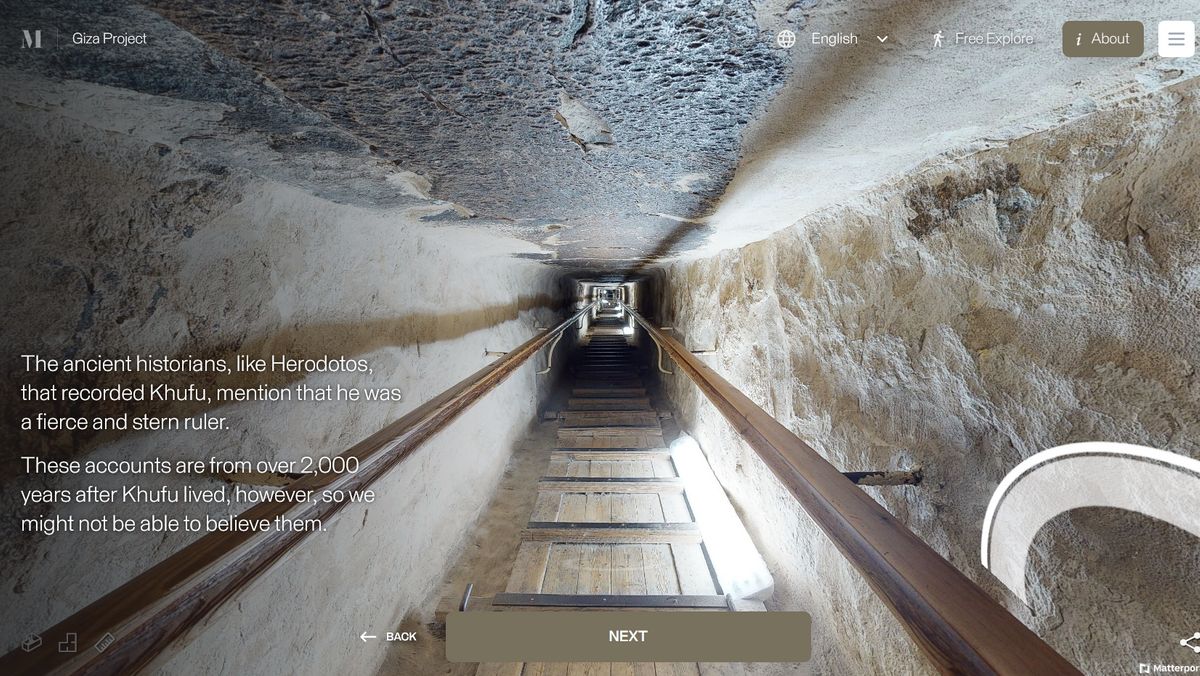Exploring the Great Pyramid of Giza: A Photo Diary

Importance and Significance
The Great Pyramid of Giza, also known as the Pyramid of Cheops or the Pyramid of Khufu, is one of the most iconic structures in the world. It is the largest of the three pyramids on the Giza Plateau in Egypt and is considered one of the Seven Wonders of the Ancient World. Built over 4,500 years ago, it continues to amaze and captivate visitors from all over the globe. Here is an exploration of the Great Pyramid of Giza through a photo diary.
The Wonder of the Great Pyramid of Giza
As one approaches the Great Pyramid of Giza, its sheer size and grandeur become apparent. Here are some key features that make it an architectural marvel:
Size and Scale: The Great Pyramid of Giza was originally built to a height of 481 feet (146 meters), making it the tallest man-made structure for over 3,800 years. It covers an area of 13 acres (5.3 hectares) and comprises approximately 2.3 million stone blocks, each weighing an average of 2.5 tons.
Precise Construction: The pyramid's construction involved such precision that it is still considered an engineering marvel today. The stones used in the outer casing were cut and placed with such accuracy that the gaps between them are less than one-fifth of an inch (5 mm). This level of precision was achieved without modern tools or machinery.
Chambers and Passages: The inside of the pyramid consists of various chambers and passages. The most famous chamber is the King's Chamber, which houses the sarcophagus believed to have once held the pharaoh's remains. The Grand Gallery's intricate corbelled roof is another impressive pyramid feature.
Solar Alignment: The Great Pyramid of Giza is aligned almost perfectly with the four cardinal directions, with only a slight deviation of a few centimetres. This precision alignment is thought to have been intentional and may have been related to the pharaoh's association with the sun god Ra.
Visitors to the Great Pyramid of Giza can witness these remarkable features firsthand and immerse themselves in this ancient wonder's rich history and cultural significance. From the breathtaking views of the Giza Plateau to the intricate details of stone craftsmanship, exploring the Great Pyramid of Giza is a truly unforgettable experience.
Stay tuned for an exciting photo journey through the Great Pyramid of Giza, highlighting its awe-inspiring architecture and timeless beauty.

The Exterior
When it comes to ancient wonders, few can compare to the magnificence of the Great Pyramid of Giza. As one of the Seven Wonders of the Ancient World, this awe-inspiring structure continues to captivate visitors from around the globe. Here is a closer look at the exterior of this iconic pyramid:
The Giza Plateau and Surroundings
Situated on the Giza Plateau, just outside the bustling city of Cairo, the Great Pyramid stands tall amidst the desert landscape. Here are some key highlights of the surrounding area:
Sphinx: Adjacent to the pyramid lies the enigmatic Sphinx. This colossal statue, with the body of a lion and the head of a human, has been a symbol of Egyptian mythology and a popular subject of fascination.
Precise Alignment: The Great Pyramid is perfectly aligned with the cardinal points of the compass. Its four sides face true north, south, east, and west, a remarkable feat considering its age.
Necropolis Complex: The pyramid is part of a larger complex that includes tombs and temples. Exploring these structures provides insight into the culture and beliefs of the ancient Egyptians.
Desert Scenery: The stark beauty of the desert landscape provides a dramatic backdrop to the pyramid. The vast expanse of sand and the clear blue skies create a serene atmosphere.
Architecture and Design of the Pyramid
The architectural brilliance of the Great Pyramid is truly remarkable. Here are some key features of its design:
Incredible Size: The Great Pyramid is the largest of the three pyramids at Giza, standing approximately 481 feet tall. It was the tallest man-made structure in the world for over 3,800 years.
Construction Materials: The pyramid was built using limestone blocks, which were painstakingly quarried and transported to the construction site. These massive blocks were precisely fitted together to create a solid structure.
Intricate Passageways: Inside the pyramid are a series of passageways and chambers that serve different purposes. The Queen's Chamber and the King's Chamber are among the main features of this impressive architectural marvel.
Alignment with Stars: The orientation of the pyramid aligns with certain stars, particularly the stars of Orion's Belt. This celestial alignment adds an additional layer of mystery and symbolism to the structure.
Engineering Marvel: The construction techniques employed in building the pyramid are a testament to the advanced engineering skills of the ancient Egyptians. The precision of the measurements and the complexity of the structure continue to marvel experts to this day.
Visiting the Great Pyramid of Giza is an unforgettable experience that allows you to witness the incredible achievements of the ancient Egyptians. From the grandeur of the exterior to its intricate design details, this iconic structure never fails to inspire a sense of wonder and awe.
To learn more about the Great Pyramid of Giza, you can visit the Wikipedia page for additional information.

The Interior
When visiting the Great Pyramid of Giza, one of the most fascinating parts is exploring the structure's interior. Inside the pyramid, various chambers and passageways glimpse the ancient world. Here are some highlights of what you can expect to see when exploring the interior of the Great Pyramid:
Chambers and Rooms Within the Pyramid
-
The King's Chamber: This is the main chamber within the pyramid and is located at the centre of the structure. It is made of beautiful red granite and was believed to be the burial chamber of Pharaoh Khufu, who commissioned the pyramid's construction.
-
The Grand Gallery: This impressive corridor leads to the King's Chamber and is known for its steep incline and high ceiling. It is made of limestone and has a polished finish, creating a stunning visual effect.
-
The Queen's Chamber: This chamber is smaller and higher within the pyramid. Although it is called the Queen's Chamber, it is unclear who it was built for. The chamber is made of limestone and has two air shafts that lead outside the pyramid.
Exploring the Passageways
-
Descending Passage: This is the main entrance of the Great Pyramid and leads down into the pyramid's interior. It is a narrow and sloping corridor that visitors must navigate to reach the chambers and rooms within.
-
Ascending Passage: This passageway connects the Grand Gallery to the outside of the pyramid. It is a narrow, steep passage that was likely used during the pyramid's construction.
-
Subterranean Chamber: Located beneath the pyramid, this chamber is unfinished and believed to be an earlier attempt at constructing a burial chamber. It is a fascinating space to explore and offers insights into the construction techniques used by the ancient Egyptians.
Visiting the interior of the Great Pyramid of Giza is an unforgettable experience that allows you to step back in time and marvel at the ingenuity and craftsmanship of the ancient Egyptians. It is a chance to witness history up close and gain a deeper appreciation for one of the world's most iconic landmarks.
You can visit this Wikipedia page to learn more about the Great Pyramid of Giza and its interior.

The Sphinx
The Sphinx is a fascinating and iconic monument located in Giza, Egypt. It is considered one of the world's most recognizable and mysterious landmarks. Here is an exploration of the history, symbolism, and mysteries surrounding the Sphinx.
History and Symbolism
The Sphinx is believed to have been built during the reign of Pharaoh Khafre, around 2558-2532 BC, as a guardian and symbol of royal power. The monument is carved out of a single limestone block, standing at a height of about 66 feet and with a length of approximately 240 feet. It depicts a mythical creature with the head of a human and the body of a lion.
The Sphinx is believed to represent the strength and wisdom of the pharaoh. The human face is thought to symbolize the intelligence and wisdom of the ruler, while the lion's body represents power and strength. The monument's placement near the pyramids of Giza is significant, as it is believed to protect these sacred structures.
The Mysterious Guardian of the Pyramid
The Sphinx has attracted numerous legends, mysteries, and theories throughout history. Here are some of the intriguing aspects of this enigmatic monument:
Missing Nose: One of the most well-known mysteries of the Sphinx is the missing nose. It is believed to have been destroyed by a cannonball during a military campaign or by religious fanatics who wanted to deface the monument.
Hidden Chambers: Several theories and speculations about hidden chambers or tunnels beneath the Sphinx exist. Some researchers believe they may contain ancient artefacts or even secret passageways leading to the nearby pyramids. However, no conclusive evidence has been found to support these claims.
Riddle of the Sphinx: In Greek mythology, the Sphinx was known for posing riddles to travellers. The most famous riddle asked by the Sphinx was, "What creature walks on four legs in the morning, two legs at noon, and three legs in the evening?" The answer is a human, who crawls as a baby, walks on two legs as an adult, and uses a cane in old age.
Restoration Efforts: Over the years, the Sphinx has undergone various restoration efforts to preserve its structure and prevent further deterioration. These efforts have included repairing and reinforcing damaged areas and clearing sand and debris from around the monument.
The Sphinx continues to be a symbol of mystery and awe, attracting visitors from around the world who marvel at its ancient beauty and rich history.
To learn more about the Sphinx, you can visit its Wikipedia page

The Pyramids Complex
The Pyramids Complex in Giza, Egypt, is a UNESCO World Heritage site and one of the Seven Wonders of the Ancient World. It is a must-visit destination for history enthusiasts and adventure seekers. Here is a closer look at the Pyramids Complex and its fascinating features:
The Valley Temple and Funerary Complexes
- The Valley Temple is a well-preserved structure made from massive limestone blocks. It was used for the purification and mummification process of the pharaohs.
- The Valley Temple is connected to the pyramids through causeways, used for processions during burial rituals.
- In addition to the Great Pyramid of Khufu (also known as Cheops), there are two other main pyramids in the complex: the Pyramid of Khafre (Chephren) and the Pyramid of Menkaure (Mycerinus).
- Each pyramid had its own mortuary temple and satellite pyramids, where the pharaoh and his family were laid to rest.
- The Sphinx, a mythical creature with a lion's body and a human head, stands adjacent to the Pyramids Complex. It is believed to symbolize the pharaoh's power and wisdom.
Other Pyramids in the Area
- Beyond the Pyramids Complex in Giza, there are more pyramids to explore in the surrounding areas of Dahshur and Saqqara.
- The Bent Pyramid in Dahshur is one of the earliest pyramids built by Pharaoh Sneferu. Its unique shape, with a noticeable shift in angle, makes it an architectural wonder.
- The Step Pyramid of Djoser in Saqqara is considered the earliest large-scale cut-stone construction and the first pyramid ever built.
- The Pyramid of King Teti in Saqqara is known for its intricate pyramid texts, which are religious writings inscribed on its walls.
- Exploring these pyramids and their historical significance provides a deeper understanding of the ancient Egyptian civilization.
Visiting the Pyramids Complex is truly an awe-inspiring experience. The sheer size and grandeur of the pyramids and their historical and cultural significance make it a must-see destination for travellers worldwide.
To learn more about the Pyramids Complex and its fascinating history, you can visit the Wikipedia page for detailed information.
Factual Data:
- The Valley Temple: https://en.wikipedia.org/wiki/Giza_Pyramid_Complex#Valley_temple

Visitor Experience
Visiting the Great Pyramid of Giza is an awe-inspiring experience that allows you to immerse yourself in ancient Egypt's rich history and architectural wonders. Here are some tips and guidelines to ensure a smooth and enjoyable visit:
Tips and Guidelines
Arrive Early: To avoid large crowds and long lines, arriving early in the morning when the site opens is recommended. This will give you ample time to explore the pyramid complex without feeling rushed.
Wear Comfortable Clothing: The pyramid complex is vast, and you may need to walk long distances. It is important to wear comfortable shoes and clothing, especially during the hot summer months. Don't forget to bring sunscreen and a hat to protect yourself from the sun.
Respect Cultural Norms: The Great Pyramid of Giza is a sacred site, and it is important to respect the local customs and traditions. Dress modestly, and avoid any behaviour that may be considered disrespectful, such as climbing or touching the monuments.
Stay Hydrated: Egypt's climate can be extremely hot, especially during summer. Staying hydrated by drinking plenty of water throughout your visit is essential. Water stations are also available in the Pyramid complex to refill your water bottles.
Follow Safety Precautions: While exploring the pyramid complex, it is important to follow all safety precautions. Stay on designated paths, avoid entering restricted areas, and listen to the instructions of your tour guide or the site staff.
Visiting the Great Pyramid of Giza
Visiting the Great Pyramid of Giza is an unforgettable experience that allows you to marvel at one of the world's ancient wonders. Here is a step-by-step guide to help you plan your visit:
Step 1: Choose a Tour: Various tour operators and travel agencies offer guided tours to the Great Pyramid of Giza. Research and choose a reputable tour that suits your preferences and budget.
Step 2: Entrance Ticket: Purchase your entrance ticket to the pyramid complex. The ticket will grant you access to the Great Pyramid of Khufu and the other pyramids and ancient structures in the area.
Step 3: Guided Tour: If you prefer a more informative and organized experience, consider booking a guided tour. A knowledgeable guide will provide insights into the history, architecture, and significance of the Great Pyramid of Giza.
Step 4: Explore the Complex: Once inside the pyramid complex, take your time to explore the various structures, including the Great Pyramid, the Sphinx, and the surrounding tombs and temples. Don't forget to take plenty of photos to document your visit.
Step 5: Visit the Pyramid Interior (optional): For daring and curious, there is an opportunity to enter the Great Pyramid and explore its interior chambers. However, this requires additional tickets and may involve tight spaces and steep passages.
Exploring the Great Pyramid of Giza is a once-in-a-lifetime experience that allows you to step back in time and witness an architectural marvel that has withstood the test of time. Plan your visit, follow the guidelines, and be prepared to be amazed by the grandeur and mystique of this ancient wonder.
